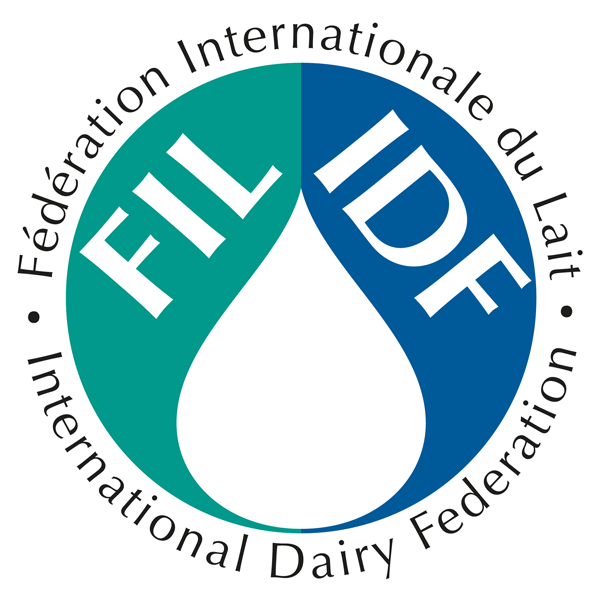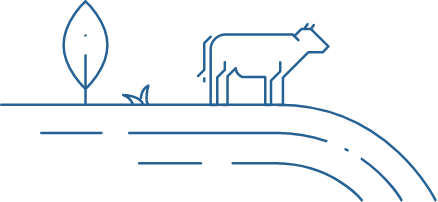Glossary
Supporting high quality milk and nutritious, safe and sustainable dairy products
Share this page
Allergy
A food allergy is an exaggerated and inappropriate immune reaction with respect to an external substance, called an allergen. It leads to the production, by the organism, of great quantities of antibodies (IgE). Generally, the allergen responsible for these reactions is a protein or a glycoprotein.
Read moreAmino-Acids
Amino acids are the basic elements of which proteins are made. The order of sequence and the amount of amino acids will produce proteins whose characteristics and functions will be quite different from one another. Amino acids are composed of an amine function (NH2) and of an acid function (COOH). Both can be described by the formula: NH2-CHR-COOH.
Read moreAntioxidant
Amino acids are the basic elements of which proteins are made. The order of sequence and the amount of amino acids will produce proteins whose characteristics and functions will be quite different from one another. Amino acids are composed of an amine function (NH2) and of an acid function (COOH). Both can be described by the formula: NH2-CHR-COOH.
Read moreAscorbic Acid
Vitamin C (or ascorbic acid) is a water-soluble vitamin, heat-sensitive and sensitive to UV and oxygen. It has an important role in hydroxylation reactions, the neutralization of free radicals and nitrosamines, the metabolism of histamine and iron, as well as anti-infectious immunological reactions.
B-Vitamins
B-vitamins form a group of water-soluble vitamins comprising vitamin B1 (thiamine), vitamin B2 (riboflavin), vitamin B2 (PP or niacin), vitamin B5 (pantothenic acid), vitamin B6 (pyridoxine), vitamin B8 (biotin), vitamin B12 (cobalamine).
Beta-Carotene
Beta-carotene (or provitamin A) is an orange- pigmented terpene. It has beneficial effects in the fight against free radicals. Contrary to vitamin A, betacarotene can not be stored in the liver and beta-carotene excess is not toxic. During digestion, one part of beta-carotene is absorbed as- is and the other part is transformed into retinol (vitamin A) by the intestinal cells.
Read moreBiogenic Amines
Biogenic amines are molecules resulting from cellular catabolism. In food, they are often of microbial origin, but can also be found in their natural state in certain products, in negligible quantities.
Read moreButter
Butter is the concentrated form of milk’s fat content. According to official regulations, butter contains at least 82% fat and at most, 16% water. Butter is produced by churning the cream portion of milk. This operation can be carried out after the cream has been ripened (light fermentation).
Read moreCalcium
The calcium content of milk is a major nutritional asset. Whether milk is full-fat or skimmed, it contains 120 mg calcium per 100 g of milk: this is a particularly high level compared to other foodstuffs such as meat (10 mg/100g), bread (27 mg/100g), and vegetables (35 mg/100g).
Calorie
The Calorie is the measuring unit of heat. It corresponds to the amount of heat necessary to bring one litre of water from 14.5° to 15.5° C, under normal atmospheric pressure. The “calorie”, used in nutrition, is in fact one kilocalorie. In the International System, the unit used to measure energy is the Joule (1 kilocalorie = 4,18 kilojoules). Lipids yield 9 Kcal/g. Carbohydrates and proteins yield 4 Kcal/g.
Carbohydrates
Carbohydrates yield energy (1g = 4 kcal) and are part of the cells’ composition.
Caseins
Caseins constitute approximately 80% of milk protein. They are present in 4 forms: alpha S 1, alpha S 2, beta and gamma caseins. They are sensitive to the pH acids (ex: lactic acid) and to coagulating enzymes (ex: rennet). These properties are used in cheese-making. These proteins are of excellent nutritional quality and, could be beneficial for some other biological effects (antimicrobic, anti-hypertensive …)
Cobalamin
Cobalamin or vitamin B12 is a vitamin that belongs to group B, water-soluble, heat- stable and sensitive to ultraviolet rays. It is involved in many chemical reactions (transmethylation, isomerization…) and in the metabolism of protein and carbohydrate.
Read moreEnergy Value
The energy value of foods depends on their content of proteins, lipids and carbohydrates. It is expressed in kJ (international unit) or kcal.
Read moreIodine
Iodine is a trace element, necessary for the synthesis of thyroid hormones. A prolonged deficiency of iodine can cause goitre. The principal food sources are products of the sea and iodized salt. The quantity of iodine found in plants, cereal or water depends on the iodine content of the soil. Milk (between 7 and 12 µg/l) and dairy products are good sources of iodine but the contents are quite variable depending on the region (soil), season and the cows’ feed.
Joule
The Joule (symbol: J) is the unit of energy of the International System. In nutrition, the term “calorie” is more often used. (1 kilocalorie = 4,18 kilojoules). The energy value for lipids in the International System is 38 kJ/g and for protein and carbohydrate, 17KJ/g.
Lactic Acid
Lactic acid is used extensively in the food industry (but also in the pharmaceutical and textile industries) for its acidifying and bacteriostatic properties. It results from sugar fermentation (hexoses) instigated by lactic bacteria.
Read moreMagnesium
Magnesium is an essential mineral that allows several enzymes to function properly. Magnesium also allows nerve impulse transmission, and is a constituent of bone and cells. Deficiency appears via a deterioration of calcium, sodium and potassium’s metabolism and induces a muscular tetany.
Maillard Reaction
The Maillard reaction results from the interaction between reducing sugars (lactose for milk) and amino acids (arginine, histidine, methionine, tryptophan and especially lysine, an amino acid found in large quantities in milk).
Read moreMilk’s Skin
Certain soluble milk proteins (albumins and globulins) are very sensitive to heat. When milk is heated, they become insoluble and coagulate to form “milk’s skin” (not to be confused with cream found on the surface of the milk). Milk’s skin is perfectly edible by those who enjoy it.
Minerals
Essential to life, minerals cannot be produced by the human body. They are classified into two categories according to their abundance in the human body.
Read moreNiacin
Niacin, also known as vitamin B3 or vitamin PP (Pellagra Preventive), is water-soluble and heat stable. It is comprised of two constituents: nicotinic acid and nicotinamide, precursor of NAD and the NADP.
Osteoporosis
Osteoporosis is a disease of the skeleton which is characterized by bone mass reduction and associated with a deterioration of the architectural quality of the bone tissue. At that point, the bone becomes more fragile and is likely to fracture during a minimal accident or a spontaneous incident.
Read morePantothenic Acid
Pantothenic acid or vitamin B5 is a water-soluble, heat-sensitive vitamin. It keeps the skin healthy and helps cuts to heal. It also helps the growth of hair and nails. Vitamin B5 is found in the majority of food products (in Greek, pantos means “that one finds everywhere”): meat and eggs, pulses/beans, dairy products. Deficiencies are exceptional.
Preservation
Preservation consists of maintaining an element in a constant state. The three technologies of preservation most used in milk are pasteurization, traditional sterilization and UHT sterilization.
Read moreRetinol
Retinol (or vitamin A) is a fat-soluble vitamin, sensitive to light, temperature and oxidation (air). It has an anti-infectious activity, plays a very important part in eye- sight (particularly at night) and also, in human growth, in the immune system and in the prevention of ageing.
Read moreSodium
Sodium is a mineral that plays an important role in the regulation of osmotic pressure of blood and liquid tissues as well as in proper muscular function. In general, it is associated with chlorine in the form of sodium chloride.
Read moreTrace Elements
Some minerals are present in the human body in a very small quantity. They are called trace elements. They are: iron, zinc, copper, manganese, iodine, selenium, chromium, molybdenum, fluoride, and cobalt. As with other minerals, they are essential to life.
Read moreVitamin A
Vitamin A (or retinol) is a fat-soluble vitamin, sensitive to light, temperature and oxidation (air). It has an anti-infectious activity, plays a very important part in eye- sight (particularly at night) and also, in human growth, in the immune system and in the prevention of ageing.
Read moreVitamin B12
Cobalamin or vitamin B12 is a vitamin that belongs to group B, water-soluble, heat- stable and sensitive to ultraviolet rays. It is involved in many chemical reactions (transmethylation, isomerization…) and in the metabolism of protein and carbohydrate.
Vitamin B3
Vitamin B3, also known as niacin or vitamin PP (Pellagra Preventive), is water-soluble and heat stable. It is comprised of two constituents: nicotinic acid and nicotinamide, precursor of NAD and the NADP.
Read moreVitamin B5
Vitamin B5 or pantothenic acid is a water-soluble, heat-sensitive vitamin. It keeps the skin healthy and helps cuts to heal. It also helps the growth of hair and nails. Vitamin B5 is found in the majority of food products (in Greek, pantos means “that one finds everywhere”): meat and eggs, pulses/beans, dairy products. Deficiencies are exceptional
Vitamin C
Vitamin C (or ascorbic acid) is a water-soluble vitamin, heat-sensitive and sensitive to UV and oxygen. It has an important role in hydroxylation reactions, the neutralization of free radicals and nitrosamines, the metabolism of histamine and iron, as well as anti-infectious immunological reactions.
Read moreWater
Water is essential to the life. It is our body’s major constituent. It infuses all our tissues and most biological and biochemical reactions require its presence.
Read more





